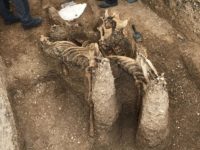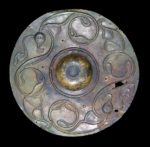 The unique chariot burial unearthed at Pocklington, East Yorkshire, in 2018 has proven even more extraordinary than it first seemed, and that’s saying a lot. This was the second chariot burial discovered at the site of a new housing development. That’s two of only 27 ever discovered in the UK, both found in a single Iron Age burial ground within a year of each other. Then, in contrast with the previously-discovered chariot burial, this one featured a chariot yolked to two ponies and buried upright, only decapitated after the grave had been filled high enough to keep them in place so they would be forever captured as in motion. No other upright chariot burials like have been found in the UK. Inside the chariot, face-down, was a bronze shield. The deceased was placed on top of it.
The unique chariot burial unearthed at Pocklington, East Yorkshire, in 2018 has proven even more extraordinary than it first seemed, and that’s saying a lot. This was the second chariot burial discovered at the site of a new housing development. That’s two of only 27 ever discovered in the UK, both found in a single Iron Age burial ground within a year of each other. Then, in contrast with the previously-discovered chariot burial, this one featured a chariot yolked to two ponies and buried upright, only decapitated after the grave had been filled high enough to keep them in place so they would be forever captured as in motion. No other upright chariot burials like have been found in the UK. Inside the chariot, face-down, was a bronze shield. The deceased was placed on top of it.
When the find was first announced, the upright burial got the lion’s share of the attention. Now that the shield has been cleaned and conserved, it is stepping into limelight as a masterpiece of Celtic art.
Specialist conservation has revealed a swirling La Tène style architecture, typical of early Celtic art, said Paula Ware, from MAP Archaeological Practice who carried out an excavation on behalf of Persimmon Homes.
She said the repousse design, made by hammering the bronze sheet from the underside, featured evidence of organic forms, such as spiralling mollusc shells creating a three-legged triskele motif, and the highly decorative asymmetrical design drew the eye to a central raised boss. […]
“The shield features a scalloped border. This previously unknown design feature is not comparable to any other Iron Age finds across Europe, adding to its valuable uniqueness.
“The popular belief is that elaborate metal-faced shields were purely ceremonial, reflecting status, but not used in battle. Our investigation challenges this with the evidence of a puncture wound in the shield typical of a sword. Signs of repairs can also be seen, suggesting the shield was not only old but likely to have been well-used,” said Paula.
 Its spiral motifs in the early Celtic La Tène style are similar to those found on the Wandsworth shield boss, recovered during dredging operations on the Thames some time before 1849 and donated to the British Museum in 1858.
Its spiral motifs in the early Celtic La Tène style are similar to those found on the Wandsworth shield boss, recovered during dredging operations on the Thames some time before 1849 and donated to the British Museum in 1858.
Persimmon Homes Yorkshire, the housing developers who own the property and the archaeological finds (non of them qualify as official treasure despite their age and immense significance because they are not made of precious metal) plan to donate them to a local museum yet to be determined.

Fantastic find, a little bit creepy that those houses will be built on an iron age burial site though.
Parking lot built over grave of Richard III, Coleridge found in a 1960s walled in wine cellar. I went on a ‘ghost’ walking tour in Boston that was pretty great, but history not ghosts as such on display: turns out the Boston Common is built over the unmarked graves of many, many Revolutionary War soldiers–mostly British. The dead seem to be all around us. But yes, some great fantasy or horror novel could be written about modern dwellers in state of the art, wifi wired smart house, only for those early warriors to rise up and… Meanwhile, I’m not sure ‘creeped’ out is the phrase I’d be looking for, but I’m kind of horrified by the image of burying live ponies neck deep then decapitating them.
Is that chariot suitable for left-hand traffic, and isn’t –despite its awesomeness– a single shield a bit meager? The decapitations, however, are not a big issue, when compared to what they usually elsewhere did at the time :skull:
——————
“…when the year comes round again, they [return to the burial mound and] do as follows:– they take the most capable of the remaining servants,–and […] strangle fifty and also fifty of the finest horses; and when they have taken out their bowels and cleansed the belly, they fill it with chaff and sew it together again. Then they set the half of a wheel upon two stakes with the hollow side upwards, and the other half of the wheel upon other two stakes, and in this manner they fix a number of these; and after this they run thick stakes through the length of the horses as far as the necks, and they mount them upon the wheels; and the front pieces of wheel support the shoulders of the horses, while those behind bear up their bellies, going by the side of the thighs; and both front and hind legs hang in the air. On the horses they put bridles and bits, and stretch the bridles tight in front of them and then tie them up to pegs: and of the fifty young men who have been strangled they mount each one upon his horse, having first run a straight stake through each body along by the spine up to the neck; and a part of this stake projects below, which they fasten into a socket made in the other stake that runs through the horse. Having set horsemen such as I have described in a circle round the tomb, they then ride away.”
——————
The shield’s decoration could be argued to have a bit of yin/yang symbolism. Just sayin.
From whence the quote?
The one about the 50 horses plus riders is from Herodotus Bk. 4.72, where he describes, after the burial itself in 4.71, what happens at the tumulus in the steppe one year after:
—————
“Ἐνιαυτοῦ δὲ περιφερομένου αὖτις ποιεῦσι τοιόνδε· λαβόντες τῶν λοιπῶν θεραπόντων τοὺς ἐπιτηδεοτάτους (οἳ δὲ εἰσὶ Σκύθαι ἐγγενέες· οὗτοι γὰρ θεραπεύουσι τοὺς ἂν αὐτὸς ὁ βασιλεὺς κελεύσῃ ἀργυρώνητοι δὲ οὐκ εἰσί σφι θεράποντες), τούτων ὦν τῶν διηκόνων ἐπεὰν ἀποπνίξωσι πεντήκοντα καὶ ἵππους τοὺς καλλίστους πεντήκοντα, ἐξελόντες αὐτῶν τὴν κοιλίην καὶ καθήραντες ἐμπιπλᾶσι ἀχύρων καὶ συῤῥάπτουσι. ἁψῖδος δὲ ἥμισυ ἐπὶ δύο ξύλα στήσαντες ὕπτιον καὶ τὸ ἕτερον ἥμισυ τῆς ἁψῖδος ἐπ᾽ ἕτερα δύο, καταπήξαντες τρόπῳ τοιούτῳ πολλὰ ταῦτα, ἔπειτα τῶν ἵππων κατὰ τὰ μήκεα ξύλα παχέα διελάσαντες μέχρι τῶν τραχήλων ἀναβιβάζουσι αὐτοὺς ἐπὶ τὰς ἁψῖδας· τῶν δὲ αἱ μὲν πρότεραι ἀψῖδες ὑπέχουσι τοὺς ὤμους τῶν ἵππων, αἱ δὲ ὄπισθε παρὰ τοὺς μηροὺς τὰς γαστέρας ὑπολαμβάνουσι· σκέλεα δὲ ἀμφότερα κατακρέμαται μετέωρα. χαλινοὺς δὲ καὶ στόμια ἐμβαλόντες ἐς τοὺς ἵππους κατατείνουσι ἐς τὸ πρόσθε αὐτῶν καὶ ἔπειτα ἐκ πασσάλων δέουσι. τῶν δὲ δὴ νεηνίσκων τῶν ἀποπεπνιγμένων τῶν πεντήκοντα ἕνα ἕκαστον ἀναβιβάζουσι ἐπὶ τὸν ἵππον, ὧδε ἀναβιβάζοντες, ἐπεὰν νεκροῦ ἑκάστου παρὰ τὴν ἄκανθαν ξύλον ὀρθὸν διελάσωσι μέχρι τοῦ τραχήλου· κάτωθεν δὲ ὑπερέχει τοῦ ξύλου τούτου τὸ ἐς τόρμον πηγνύουσι τοῦ ἑτέρου ξύλου τοῦ διὰ τοῦ ἵππου. ἐπιστήσαντες δὲ κύκλῳ τὸ σῆμα ἱππέας τοιούτους ἀπελαύνουσι.“
That is a horrific account.
But that’s Herodotus talking about the Scythians, not the Celts.
I found out that I may have ancestors that lived in that area and possibly an ancestor who was one of these chariot riders. I took My True Ancestery for fun and it came back with this result.
Elite Charioteer Briton Pocklington Yorkshire England
mtDNA Haplogroup: J1c9
Y-DNA Haplogroup: R1b1a1b1a1a2c1 (A228)
Deep Dive Match! 13% closer than others who share this deep dive sample
Genetic Distance: 5.6002
Sample Match! 96% closer than other users